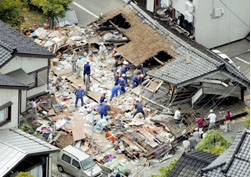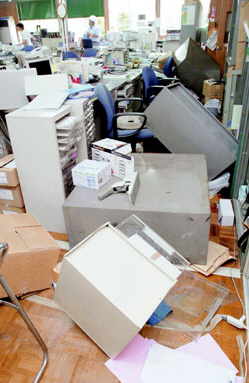Compiled from Kyodo, AP
A severe earthquake wreaked havoc on a wide
portion of Niigata Prefecture and
surrounding areas Monday morning, killing
seven people, injuring more than 830 and
destroying 500 houses.
|

|
|
A house lies flattened Monday
morning after an earthquake
measuring upper 6 on the Japanese
seismic intensity scale jolted
Niigata Prefecture at 10:13 a.m.
NIIGATA-NIPPO PHOTO / KYODO |
The Meteorological Agency said the quake had
a magnitude of 6.8 and registered a rare
upper 6 on the Japanese seismic intensity
scale, which tops out at 7.
"The quake was so fierce, I felt I couldn't
stand up," said a woman who operates a
Japanese-style inn in Kashiwazaki, Niigata
Prefecture. She said her home was a mess,
with broken plates and an overturned
television.
The quake struck at 10:13 a.m., destroying
hundreds of houses in Kashiwazaki,
firefighters said. Most were older
structures made of wood.
"I was so scared — the violent shaking went
on for 20 seconds," Lawson convenience store
clerk Ritei Wakatsuki said by phone from
Kashiwazaki. "I almost fainted from the fear
of the shaking."
"There was a sharp horizontal shaking
lasting dozens of seconds," gas station
employee Hiroki Takahashi told NHK in
Kashiwazaki. "I could hardly stand up."
The seven deceased were identified as Etsuko
Nakamura, 81, Noriko Nakamura, 78, Sansaku
Takahashi, 83, Toshio Tobita, 82, Katsuichi
Shimojo, 76, and his wife, Yasuko, 72, all
of Kashiwazaki, and Kiyo Igarashi, 79, of
Kariwa, Niigata Prefecture, local police
said.
|

|
|
Ground Self-Defense Force personnel
carry a person injured in Monday's
quake to a helicopter.
DEFENSE MINISTRY PHOTO / KYODO |
Flames and black smoke were seen pouring
from the No. 3 reactor at Tokyo Electric
Power Co.'s Kashiwazaki-Kariwa nuclear power
plant, which shut down automatically during
the quake.
The fire, caused by an electrical
transformer, was later extinguished.
Although Tepco initially said no
radioactivity was released, it later said an
unspecified amount of water containing
radioactive material leaked. No further
details were immediately available.
In Kashiwazaki, about 200 people escaped
disaster when the ceiling of a gymnasium
collapsed during a badminton tournament,
leaving one person with a slight facial
injury.
Niigata Gov. Hirohiko Izumi asked the
central government to send Ground
Self-Defense Force troops to help with
rescue and recovery efforts in the area.
A total of 10,000 people were evacuated by
late Monday night in Kashiwazaki and other
towns in Niigata Prefecture, local officials
said.
The quake, which also was felt in Tokyo, was
followed by a 4.2-magnitude quake at 10:34
a.m.
|

|
|
Office equipment lies strewn about
the Iizuna Town Hall on Monday
morning after a powerful earthquake
rocked northwest Japan, killing at
least five people and leaving
hundreds injured.
SHINANO MAINICHI SHIMBUN PHOTO /
KYODO |
The quake had an intensity of upper 6 in
Kashiwazaki and Kariwa, Niigata Prefecture,
and in Iizuna, Nagano Prefecture. It
registered lower 6 in Joetsu and Nagaoka in
Niigata, and upper 5 in Iiyama in Nagano.
Its focus was about 17 km under the seabed
off Niigata Prefecture, the Meteorological
Agency said.
A tsunami warning was issued for parts of
Sado Island and other coastal areas after
the quake but was lifted about an hour
later.
The powerful quake caused transportation to
grind to a halt and several blackouts were
reported.
Tepco said the No. 3 reactor along with
three other reactors at the
Kashiwazaki-Kariwa plant were shut down.
The Tohoku, Joetsu and Nagano shinkansen
lines were halted following the quake but
had resumed operations by evening, East
Japan Railway Co. said.
A local train car was knocked off the rails
while stopped at JR Kashiwazaki Station, but
no one was hurt.
Expressways were shut down for safety checks
after landslides hit several roads in
Niigata Prefecture.
Niigata
Airport, which suspended
flights shortly after the quake, resumed
services after finding no damage.
Water and gas were cut off in Kashiwazaki,
and about 35,000 households in Niigata
Prefecture and 21,000 in Nagano Prefecture
were without power at one point.
Aftershocks continued to rattle the area,
including one that came in at lower 6 on the
intensity scale. Koichi Uhira of the
Meteorological Agency warned that
aftershocks could continue for as long as a
week.
In October 2004, Niigata was hit by a
magnitude-6.8 earthquake that killed 40
people and damaged more than 6,000 homes. It
was the deadliest to hit Japan since 1995.

